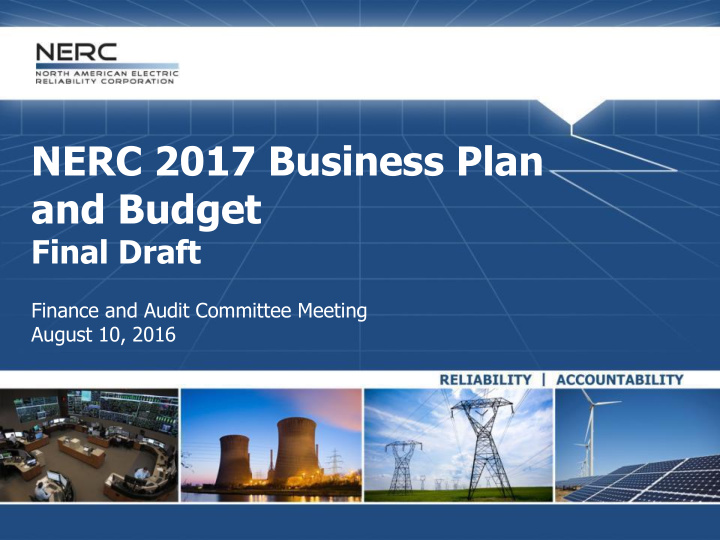



NERC 2017 Business Plan and Budget Final Draft Finance and Audit Committee Meeting August 10, 2016
Major Areas of Focus • Activities supporting Goals and objectives in the Strategic Plan RISC Priorities Standing Committees • Increasing NERC’s analytical capabilities • E-ISAC operations • Enterprise Risk Management • Highly skilled workforce • Resource allocation and efficiency of operations 2 RELIABILITY | ACCOUNTABILITY
Updates Since Draft 1 • Personnel costs and assumptions Updated personnel allocations and costs based on latest projections FTEs are slightly lower than Draft 1 Minor changes in other personnel categories • Updated budget to reflect funding of further improvements to E-ISAC portal • Other costs remain close to Draft 1, with minor adjustments 3 RELIABILITY | ACCOUNTABILITY
2017 Budget – Final Draft Summary • Total NERC before additional E-ISAC portal investment Budget increase unchanged at 2.5% Assessment increase unchanged at 4.5% • Total NERC with additional E-ISAC portal investment Adds another 1.1% to total budget increase o 3.6% overall, 3.5% without CRISP Adds another 0.4% to total assessment increase o 4.9% overall, 4.7% without CRISP o Includes release of $1.1M in Assessment Stabilization Reserves • CRISP Finalizing budget with Battelle and participants Anticipate minimal changes between 2016 and 2017 4 RELIABILITY | ACCOUNTABILITY
2017 Budget – Final Draft Summary 2016 2017 Variance $ Variance % Budget Budget Over(Under) Over(Under) Expenses Personnel Expenses $ 37,283,807 $ 38,641,331 $ 1,357,525 3.6% Meeting Expenses 3,620,286 3,372,886 (247,400) -6.8% Operating Expenses 24,903,515 24,800,690 (102,825) -0.4% Other Non-Operating Expenses 110,000 106,725 (3,275) -3.0% Total Expenses $ 65,917,608 $ 66,921,632 $ 1,004,024 1.5% Inc(Dec) in Fixed Assets 1,269,057 2,680,543 1,411,486 111.2% TOTAL BUDGET $ 67,186,665 $ 69,602,175 $ 2,415,510 3.6% FTEs 192.47 189.88 (2.58) -1.3% • Personnel expenses include salaries, at-risk incentive compensation, benefits, temporary staffing, and training. In addition to those categories, overall personnel expense is increasing in part due to lower attrition and stabilizing workforce. • Change in fixed assets, excluding depreciation and allocations, is an increase of $461,000. 5 RELIABILITY | ACCOUNTABILITY
Budget By Program Area 6 RELIABILITY | ACCOUNTABILITY
Budget By Program Area without CRISP Note: CRISP is funded largely by third-parties. This chart reflects the distribution of resources funded primarily by assessments. 7 RELIABILITY | ACCOUNTABILITY
NERC Resource Allocation to Strategic Goal Areas NERC Resource Allocation to Strategic Goal Areas Regional Goal 2 Oversight 13% Goal 5 Compliance Coordination and Monitoring, Collaboration Enforcement, 17% Registration, and Certification 8% 17% 3a Risk Goal 1 Standards 3b Events 13% 3c E-ISAC Goals 3 & 4 27% Risks to Reliability 3d Modeling 53% 4a Assessments CRISP Participant Funding 2% 3% Highest Priority Risks • Changing Resource Mix • Inadequate Planning Coordination • Ineffective Resource Planning • Cyber Security 8 RELIABILITY | ACCOUNTABILITY
Assessment Stabilization Strategy • Multi-year strategy to better align budget increases, assessment requirements, and billed assessments • Phased release of Assessment Stabilization Reserves* 2017 assessment increase at 4.9% 2018 assessment increase +/- 3.8% 2019 assessment increase +/- 3.1% 2020 and beyond +/- 3.0% declining toward 2.7% • Actual budget increases and use of reserves determined annually * Assumed 2.5% budget increase for modeling purposes 9 RELIABILITY | ACCOUNTABILITY
Assessment Stabilization Reserve Projection/Recommendation • ASR projected at $1,671,000 for year-end 2017 Balance at beginning of 2016 = $2,271,000 Received $500k penalty in May 2016 o Restricted in 2016, unrestricted and available for ASR in 2017* Balance at beginning of 2017 = $2,771,000 Releasing $1,100,000 from ASR in 2017 to offset assessments* Balance at end of 2017 = $1,671,000 Expect $500k penalty in May 2017, restricted in 2017, unrestricted in 2018 and available for ASR subject to requisite approvals * In conjunction with the 2017 budget approval, management recommends the deposit of $500k into the ASR on 1/1/17 and the release of $1,100,000 from the ASR to offset 2017 assessment. 10 RELIABILITY | ACCOUNTABILITY
Other Reserve Balances Projected 2017 Year-End • Future Obligation Reserves - $2.6M • Operating Contingency Reserve - $2.2M Conservative projection, generally target $2M • System Operator Certification Reserve - $714k • CRISP Reserve - $500k Funded by participants, subject to final budget negotiation 11 RELIABILITY | ACCOUNTABILITY
Assessment Increases by Country • Total NERC Assessment Increase – 4.9% U.S. Increase – 4.9% Canada Increase – 4.2% Mexico Increase – 10.8% o Primarily resulting from an increase in NEL 12 RELIABILITY | ACCOUNTABILITY
Total Canadian Assessments % Change - 2017 v 2016 $ Change - 2017 v 2016 Total RE NERC Total RE NERC FINAL Assessment Assessment Assessment Assessment Assessment Assessment AESO -5.1% -10.2% 5.9% $ (82,120) $ (112,454) $ 30,334 IESO 1.2% -0.1% 3.3% 37,474 (1,498) 38,972 New Brunswick 0.6% -2.0% 7.3% 2,567 (5,939) 8,506 Quebec 0.5% -0.5% 2.1% 23,122 (14,650) 37,772 Nova Scotia -0.1% -3.1% 5.0% (304) (7,528) 7,224 Manitoba Hydro -3.1% -4.6% 1.2% (38,907) (42,827) 3,920 SaskPower 1.5% -0.1% 6.0% 18,128 (590) 18,718 British Columbia Hydro 3.0% 0.6% 9.1% 82,930 11,203 71,728 Total Canada 0.3% -1.7% 4.2% $ 42,891 $ (174,282) $ 217,173 13 RELIABILITY | ACCOUNTABILITY
Budget/Assessment Trend • NERC’s assessment increasing more than Regions for a variety of reasons • Broader responsibilities E-ISAC ERO Enterprise application development and maintenance Broader analytical needs and capabilities • Personnel costs represent majority of costs Larger workforce Even stable workforce yields upward pressure on budget 14 RELIABILITY | ACCOUNTABILITY
15 RELIABILITY | ACCOUNTABILITY
Recommend
More recommend